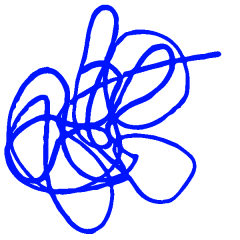The „100 Screengrabs“ were supposed to be a straightforward approach to an iterative working method. A set up of constraints and time limitations were meant to help narrow down the possibilities of what can be produced and create a clear approach. A doodle of a banana from the previous „Elaborate“ project should be iteration zero. The constraints were set in a chain of alterations that can be made. First, the shape can be changed, then the texture and at last the filling/colour. The three steps reset after every colour change and the chain starts from the beginning. The conditions are to only use the elements at hand without adding anything from outside. Also, with every step, there was the possibility to go back to the original shape, texture, or colour. Additionally, there was a time limit of maximum two minutes that can be spent with one alteration.
Executing the chain of constraints still left too much room for arbitrary changes.
The possibilities of altering the image after every step were still too indiscriminate to make sense. Besides learning how to work iteratively, the search for deeper meaning and purpose took over once again. The 100 images constructed out of banana doodle elements didn’t feel straightforward enough. The experimentation of what possibilities could arise from setting constraints to rearrange the same elements created a strong feeling of frustration and rejection towards the working method and type of work.
Even though the process didn’t work out as wished there have been some insights coming from the way the project was approached. Using the elements of a banana doodle to challenge the limits of what shape, texture and colour is still tied to a banana. Finding a new definition of what a banana is with every iteration. Through that, the banana iterations challenge the slipperiness of formal and semantic definitions. Also, the bananas challenge the meaning and possibilities of constraints within the design practice and how setting a framework can sometimes still lead to arbitrary outcomes. The project raises the question of how to set constraints that balance the fine line between openness, clarity and straightforwardness? Also, what place does intuition take on within a research design approach? To which degree is intuition reasonable?
Going further from this project the arbitrariness of the choices made within the constraints is something I want to eliminate from the approach. The framework should be set up clearer and more straightforward in the future. Looking at Raymond Queneau’s work „Exercises in style“ the constraints he set himself to rewrite the same story in several different styles is a good example of a balance between straightforwardness and still enough space to vary within the constraint. The possibility of variation is not within choosing the style but within the style itself. Whereas the 100 bananas still offer a broad range of different shapes, textures and colours that can be chosen from. So, the constraint always has to be set with a sense of direction or aim.
From looking at previous methods of working I identified that a process of collecting information and processing it, preferably with illustration, is the most natural way for me to interrogate a topic. An initial aim set at the beginning that is straightforward but also open is still a challenge. For me, it is important to have a topic or area of interest I can exhaust. The method of challenging common definitions is something I’m interested in but I still can’t connect it to a topic without overthinking the outcomes.
Skip to content
